How to Uninstall Pc Accelerate on Windows 10
What is PC Accelerator?
Developers present PC Accelerator as a great tool to optimize and speed up your computer. Initially, this app may seem legitimate and useful, however, PC Accelerator is categorized as a potentially unwanted program (PUP). PC Accelerator often infiltrates systems without permission and provides no real value for regular users.
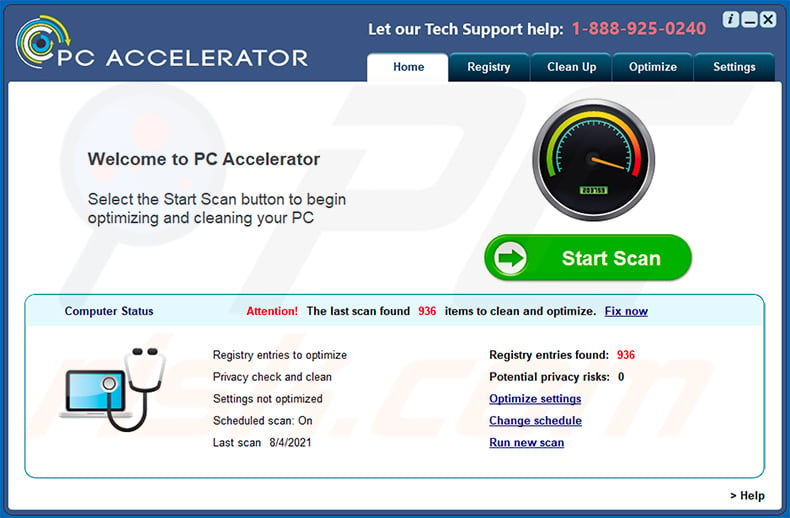
After running PC Accelerator and scanning the system, users are prompted with many 'issues' that must be resolved. Since the 'free version' of PC Accelerator is not capable of these functions, however, users are encouraged to purchase the 'full version'. This is a scam. The entire list of issues is false - your system is likely to be perfectly optimized and issue free.
Furthermore, PC Accelerator provides no significant value. Criminals use this application to trick users into purchasing supposed full versions that are useless. Developers generate revenue by abusing users' trust. For these reasons, you should uninstall the PC Accelerator PUP and certainly do NOT pay for the full version. Note also how PC Accelerator is installed.
As mentioned above, it is likely to infiltrate systems without permission. There is a high probability that it will install together with a number of other PUPs. In most cases, potentially unwanted programs do three things: 1) display intrusive advertisements [adware]; 2) modify web browser options [browser hijackers], and; 3) gather various information [typically, many types]. As with PC Accelerator, these apps are also useless. Therefore, we strongly recommend that you uninstall all PUPs as soon as possible.
| Name | PC Accelerator potentially unwanted program |
| Threat Type | PUP (potentially unwanted program), PUA (potentially unwanted application) |
| Supposed Functionality | System optimization, junk/malware removal |
| Detection Names (PC Accelerator installer setup) | BitDefender (Adware.GenericKD.30827674), Emsisoft (Adware.GenericKD.30827674 (B)), ESET-NOD32 (Multiple Detections), Kaspersky (Hoax.Win32.SpeedUpMyPC.glw), McAfee (Artemis!04B2C0A662B2), Full List Of Detections (VirusTotal) |
| Detection Names (PC Accelerator application) | Fortinet (Riskware/SpeedUpMyPC), ESET-NOD32 (A Variant Of Win32/SpeedingUpMyPC), Malwarebytes (PUP.Optional.PCAccelerator), TrendMicro (PUA_PCAccelerator), Full List Of Detections (VirusTotal) |
| Symptoms | A program that you do not recall installing suddenly appeared on your computer. A new application is performing computer scans and displays warning messages about 'found issues'. Asks for payment to eliminate the supposedly found errors. |
| Distribution Methods | Deceptive pop-up ads, free software installers (bundling), fake Flash Player installers. |
| Damage | Monetary loss (unnecessary purchase of fake software), unwanted warning pop-ups, slow computer performance. |
| Malware Removal (Windows) | To eliminate possible malware infections, scan your computer with legitimate antivirus software. Our security researchers recommend using Combo Cleaner. |
PC Accelerator shares many similarities with Advanced PC Care, PCMax, System Keeper, and dozens of other potentially unwanted programs. In fact, all are virtually identical. By offering "useful features", PUPs attempt to give the impression of legitimacy, but are designed only to help developers generate revenue.
Rather than enabling the functionality promised, potentially unwanted programs deliver intrusive advertisements (via the "Pay Per Click" [PPC] advertising model), promote rogue sites (unwanted redirects), gather sensitive data (information sales), and, in this case, promote in-app purchases. These programs pose a direct threat to your privacy and Internet browsing safety.
How did PC Accelerator install on my computer?
Potentially unwanted programs are often distributed using intrusive advertising and "bundling" methods. Intrusive advertisements redirect to malicious websites and run scripts that stealthily download and install malware or PUPs. "Bundling" is stealth installation of third party applications together with regular programs.
Developers do not disclose these installations properly - they hide "bundled" apps within "Custom/Advanced" settings or other sections of the download/installation processes. Furthermore, many users click dubious links/ads and skip download/installation steps. This behavior often leads to inadvertent installation of potentially unwanted programs.
How to avoid installation of potentially unwanted applications?
The main reasons for computer infections are poor knowledge and careless behavior. The key to safety is caution. To prevent system infiltration by PUPs, be very cautious when downloading/installing software and browsing the Internet. Carefully analyze each step of the download/installation processes using the "Custom" or "Advanced" settings. Opt-out of all additionally-included programs and decline offers to download/install them.
We also advise you to download your applications from official sources only, using direct download links. Third party downloaders/installers are often monetized using the "bundling" method, and thus, these tools should not be used. Be aware that intrusive ads usually seem legitimate, but redirect to gambling, adult dating, pornography, and other dubious websites. If you encounter these redirects, immediately remove all dubious applications and browser plug-ins.
Appearance of PC Accelerator unwanted application (GIF):
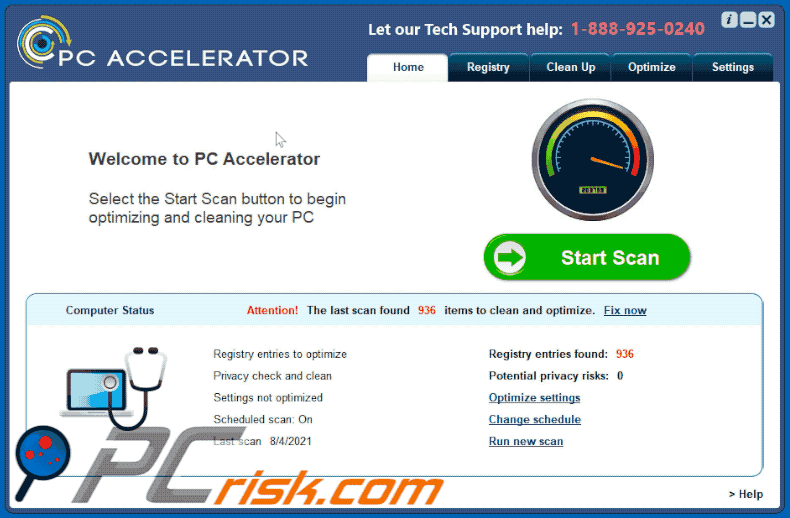
Screenshot of PC Accelerator installation setup:
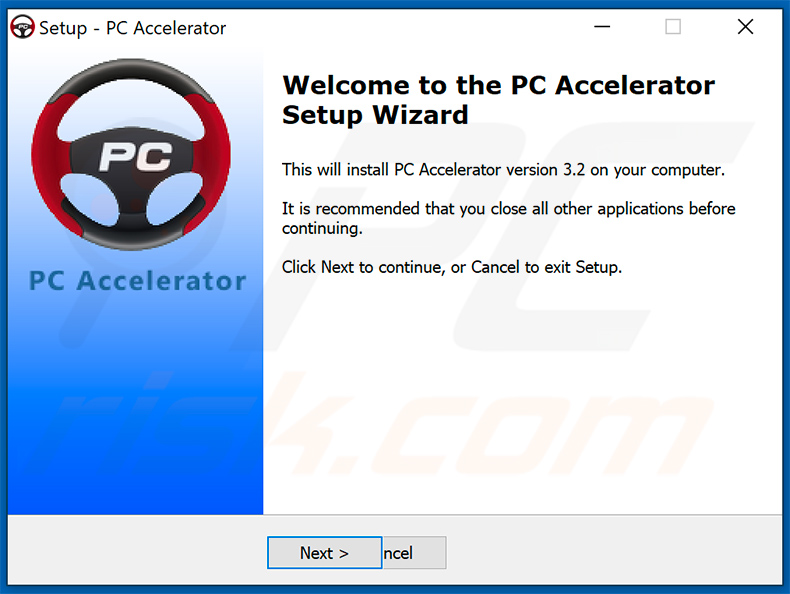
Screenshot of a website used to promote PC Accelerator:
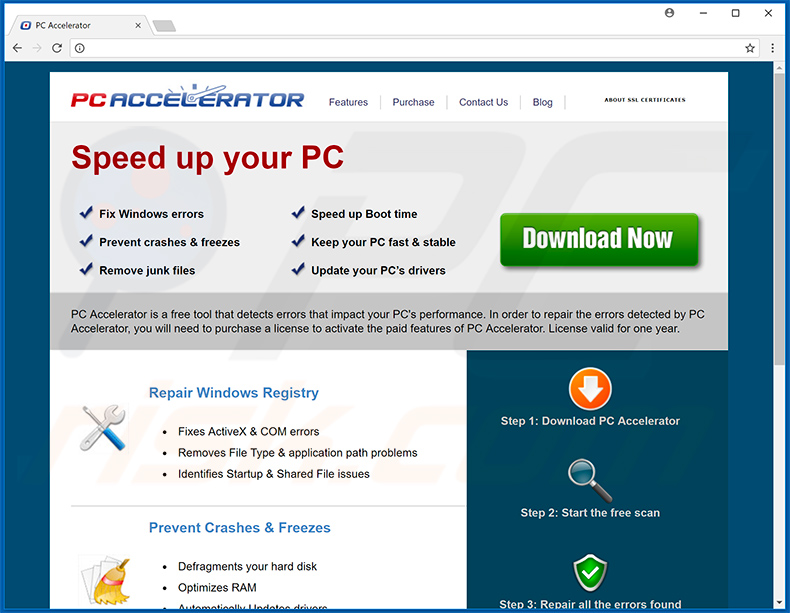
Instant automatic malware removal: Manual threat removal might be a lengthy and complicated process that requires advanced computer skills. Combo Cleaner is a professional automatic malware removal tool that is recommended to get rid of malware. Download it by clicking the button below:
▼ DOWNLOAD Combo Cleaner By downloading any software listed on this website you agree to our Privacy Policy and Terms of Use. To use full-featured product, you have to purchase a license for Combo Cleaner. 7 days free trial available. Combo Cleaner is owned and operated by Rcs Lt, the parent company of PCRisk.com read more.
Quick menu:
- What is PC Accelerator?
- STEP 1. Uninstall deceptive applications using Control Panel.
- STEP 2. Remove rogue extensions from Google Chrome.
- STEP 3. Remove potentially unwanted plug-ins from Mozilla Firefox.
- STEP 4. Remove rogue extensions from Safari.
- STEP 5. Remove rogue plug-ins from Microsoft Edge.
Removal of potentially unwanted applications:
Windows 11 users:

Right-click on the Start icon, select Apps and Features . In the opened window search for the application you want to uninstall, after locating it, click on the three vertical dots and select Uninstall .
Windows 10 users:

Right-click in the lower left corner of the screen, in the Quick Access Menu select Control Panel . In the opened window choose Programs and Features .
Windows 7 users:

Click Start (Windows Logo at the bottom left corner of your desktop), choose Control Panel . Locate Programs and click Uninstall a program .
macOS (OSX) users:
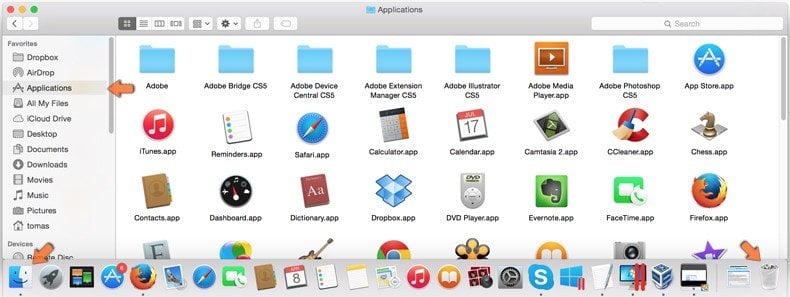
Click Finder , in the opened screen select Applications . Drag the app from the Applications folder to the Trash (located in your Dock), then right click the Trash icon and select Empty Trash .
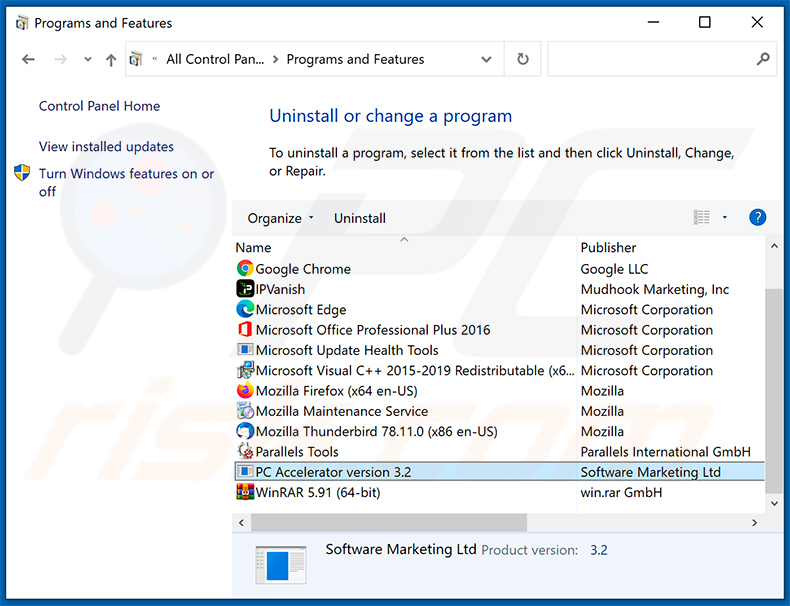
In the uninstall programs window, look for "PC Accelerator" and other suspicious/recently-installed applications, select these entries and click "Uninstall" or "Remove".
After uninstalling the potentially unwanted application, scan your computer for any remaining unwanted components or possible malware infections. To scan your computer, use recommended malware removal software.
Remove rogue extensions from Internet browsers:
At time of research, PC Accelerator did not install any unwanted browser extensions, however, some unwanted applications can be installed together with adware and browser hijackers. If you experience unwanted ads or redirects when browsing the internet, continue with the removal guide below.
Video showing how to remove potentially unwanted browser add-ons:
 Remove malicious extensions from Google Chrome:
Remove malicious extensions from Google Chrome:
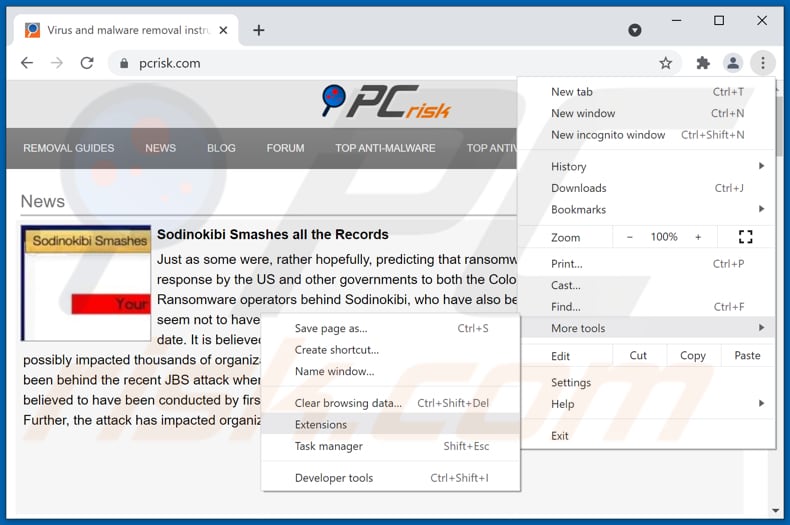
Click the Chrome menu icon![]() (at the top right corner of Google Chrome), select "More tools" and click "Extensions". Locate all recently-installed suspicious browser add-ons and remove them.
(at the top right corner of Google Chrome), select "More tools" and click "Extensions". Locate all recently-installed suspicious browser add-ons and remove them.
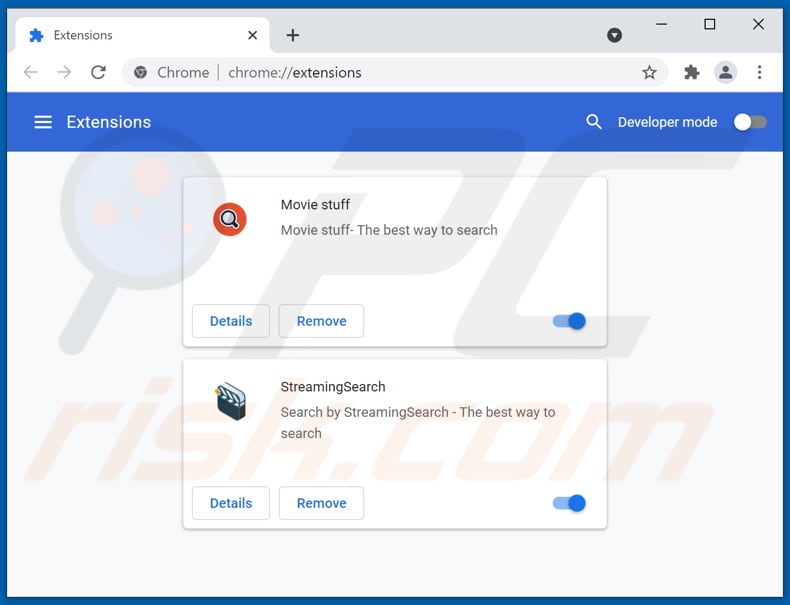
Optional method:
If you continue to have problems with removal of the pc accelerator potentially unwanted program, reset your Google Chrome browser settings. Click the Chrome menu icon ![]() (at the top right corner of Google Chrome) and select Settings . Scroll down to the bottom of the screen. Click the Advanced… link.
(at the top right corner of Google Chrome) and select Settings . Scroll down to the bottom of the screen. Click the Advanced… link.

After scrolling to the bottom of the screen, click the Reset (Restore settings to their original defaults) button.

In the opened window, confirm that you wish to reset Google Chrome settings to default by clicking the Reset button.

 Remove malicious plugins from Mozilla Firefox:
Remove malicious plugins from Mozilla Firefox:
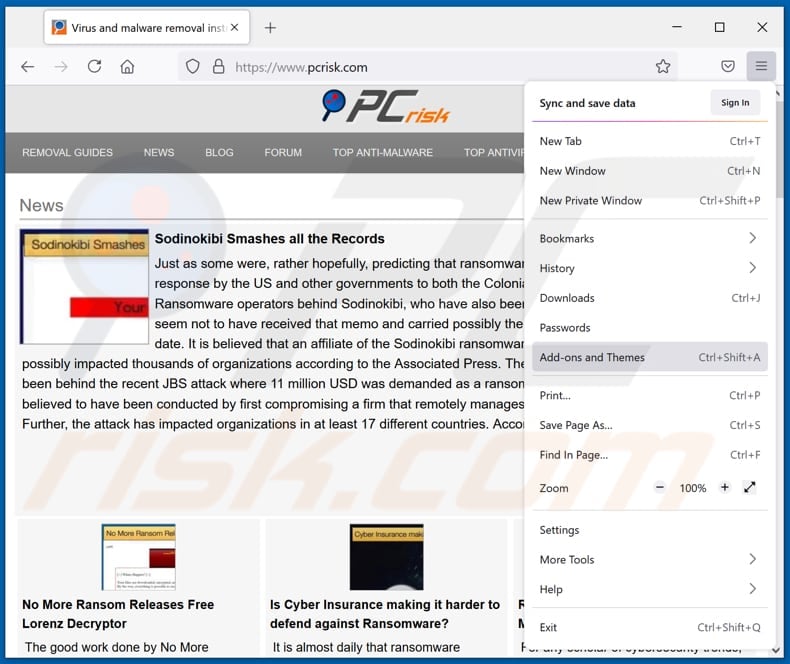
Click the Firefox menu ![]() (at the top right corner of the main window), select "Add-ons". Click on "Extensions", in the opened window remove all recently-installed suspicious browser plug-ins.
(at the top right corner of the main window), select "Add-ons". Click on "Extensions", in the opened window remove all recently-installed suspicious browser plug-ins.
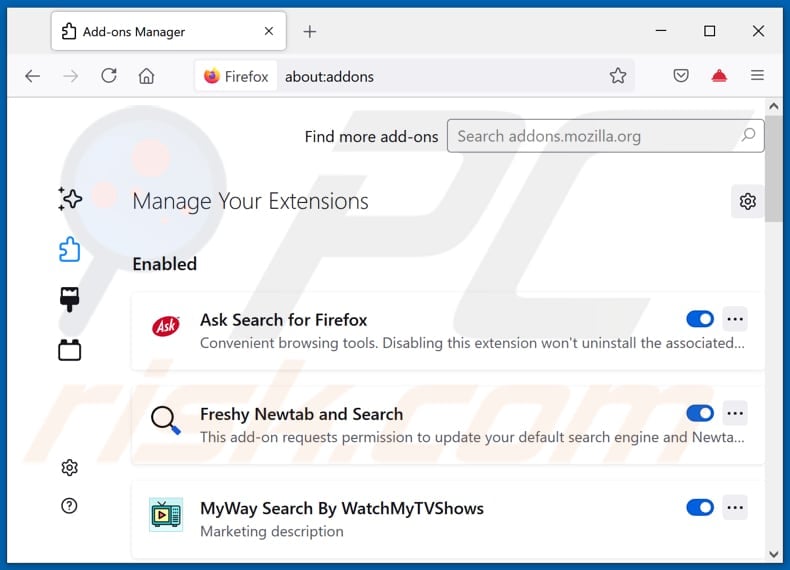
Optional method:
Computer users who have problems with pc accelerator potentially unwanted program removal can reset their Mozilla Firefox settings.
Open Mozilla Firefox, at the top right corner of the main window, click the Firefox menu , ![]() in the opened menu, click Help.
in the opened menu, click Help.

Select Troubleshooting Information .

In the opened window, click the Refresh Firefox button.

In the opened window, confirm that you wish to reset Mozilla Firefox settings to default by clicking the Refresh Firefox button.

 Remove malicious extensions from Safari:
Remove malicious extensions from Safari:

Make sure your Safari browser is active, click Safari menu , and select Preferences... .

In the opened window click Extensions , locate any recently installed suspicious extension, select it and click Uninstall .
Optional method:
Make sure your Safari browser is active and click on Safari menu. From the drop down menu select Clear History and Website Data...

In the opened window select all history and click the Clear History button.

 Remove malicious extensions from Microsoft Edge:
Remove malicious extensions from Microsoft Edge:

Click the Edge menu icon![]() (at the upper-right corner of Microsoft Edge), select "Extensions". Locate all recently-installed suspicious browser add-ons and click "Remove" below their names.
(at the upper-right corner of Microsoft Edge), select "Extensions". Locate all recently-installed suspicious browser add-ons and click "Remove" below their names.

Optional method:
If you continue to have problems with removal of the pc accelerator potentially unwanted program, reset your Microsoft Edge browser settings. Click the Edge menu icon ![]() (at the top right corner of Microsoft Edge) and select Settings .
(at the top right corner of Microsoft Edge) and select Settings .

In the opened settings menu select Reset settings .

Select Restore settings to their default values . In the opened window, confirm that you wish to reset Microsoft Edge settings to default by clicking the Reset button.

- If this did not help, follow these alternative instructions explaining how to reset the Microsoft Edge browser.
Summary:
 Commonly, adware or potentially unwanted applications infiltrate Internet browsers through free software downloads. Note that the safest source for downloading free software is via developers' websites only. To avoid installation of adware, be very attentive when downloading and installing free software. When installing previously-downloaded free programs, choose the custom or advanced installation options – this step will reveal any potentially unwanted applications listed for installation together with your chosen free program.
Commonly, adware or potentially unwanted applications infiltrate Internet browsers through free software downloads. Note that the safest source for downloading free software is via developers' websites only. To avoid installation of adware, be very attentive when downloading and installing free software. When installing previously-downloaded free programs, choose the custom or advanced installation options – this step will reveal any potentially unwanted applications listed for installation together with your chosen free program.
Post a comment:
If you have additional information on pc accelerator potentially unwanted program or it's removal please share your knowledge in the comments section below.
About the author:

Tomas Meskauskas - expert security researcher, professional malware analyst.
I am passionate about computer security and technology. I have an experience of over 10 years working in various companies related to computer technical issue solving and Internet security. I have been working as an author and editor for pcrisk.com since 2010. Follow me on Twitter and LinkedIn to stay informed about the latest online security threats. Contact Tomas Meskauskas.
PCrisk security portal is brought by a company RCS LT. Joined forces of security researchers help educate computer users about the latest online security threats. More information about the company RCS LT.
Our malware removal guides are free. However, if you want to support us you can send us a donation.
How to Uninstall Pc Accelerate on Windows 10
Source: https://www.pcrisk.com/removal-guides/12561-pc-accelerator-pup